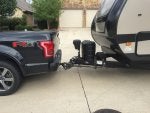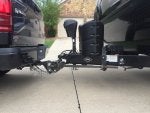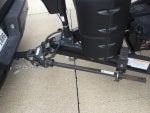Hey guys, new to the forum here, been reading a bunch here lately.
We have a 2015 S-Crew FX4 3.5EcoBoost w/Max Trailer Tow Package.
Using a Husky Centerline WD hitch with 801-1200lb bars
We have a 35' Evergreen Texan 314BDS Trailer, Manufacturers specs state:
When we bought the trailer new, it had a sticker by the door stating that the dry weight is 6800lbs(from the dealership), no tongue weight listed there.
I went to the CAT scales here today and got weighed with and without trailer attached.
Trailer axles: 6,480lbs
Tongue Wght: 1,040lbs
GVW: 7,520lbs
Steer Axle: 2,900lbs
Drive Avle: 3,700lbs
Trailer Axle: 6,640lbs
GCWR: 13,240lbs
Just the truck with cargo and WD Hitch w bars was 5,700lbs, plus another 400lbs with all the family on board.
Payload sticker is 1,594lbs
Front GAWR: 3525lbs
Rear GAWR: 3800lbs
After weighing, I relocated 75-100lbs to the rear of the trailer, so that should bring my tongue weight down in the neighborhood of 950. Any other tips to lighten the tongue weight? I though about carrying 8-10 gallons in the black tank to maybe lighten the TW up a little bit maybe??
Regarding the truck axle weights, how can i adjust the WD hitch, if any, to push more weight to the front axle and also back to the trailer axles?
Heres a few pics.
![]()
![]()
![]()
![]()
![]()
We have a 2015 S-Crew FX4 3.5EcoBoost w/Max Trailer Tow Package.
Using a Husky Centerline WD hitch with 801-1200lb bars
We have a 35' Evergreen Texan 314BDS Trailer, Manufacturers specs state:
| Hitch Weight | 599 lbs |
| Gross Weight | 8750 lbs |
| Dry Weight | 6102 lbs |
| Cargo Weight | 2349 lbs |
I went to the CAT scales here today and got weighed with and without trailer attached.
Trailer axles: 6,480lbs
Tongue Wght: 1,040lbs
GVW: 7,520lbs
Steer Axle: 2,900lbs
Drive Avle: 3,700lbs
Trailer Axle: 6,640lbs
GCWR: 13,240lbs
Just the truck with cargo and WD Hitch w bars was 5,700lbs, plus another 400lbs with all the family on board.
Payload sticker is 1,594lbs
Front GAWR: 3525lbs
Rear GAWR: 3800lbs
After weighing, I relocated 75-100lbs to the rear of the trailer, so that should bring my tongue weight down in the neighborhood of 950. Any other tips to lighten the tongue weight? I though about carrying 8-10 gallons in the black tank to maybe lighten the TW up a little bit maybe??
Regarding the truck axle weights, how can i adjust the WD hitch, if any, to push more weight to the front axle and also back to the trailer axles?
Heres a few pics.









